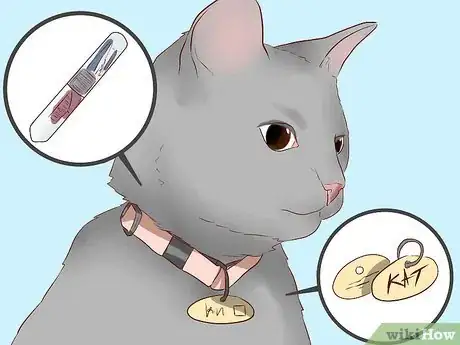This article was co-authored by Pippa Elliott, MRCVS. Dr. Elliott, BVMS, MRCVS is a veterinarian with over 30 years of experience in veterinary surgery and companion animal practice. She graduated from the University of Glasgow in 1987 with a degree in veterinary medicine and surgery. She has worked at the same animal clinic in her hometown for over 20 years.
This article has been viewed 193,264 times.
Losing track of your cat can be a scary experience. It may be difficult to find them or to know where to start your search. Thankfully, there are some steps you can take to protect your cat from becoming lost and make it easier to find your cat if they do go wandering.
Steps
Looking Inside the Home
-
1Remain calm. Losing track of your cat can be nerve-racking. Keeping calm will help you think clearly and make the most of your search. Stay relaxed and look for your cat as calmly as you can to increase the odds of you finding them.[1]
- Get a flash-light to help you in your search.
- Think about where you last saw your cat and start the search there.
- Keep focused. Search everywhere you can think to look.
- Search systematically. Look in all the possible hiding spots in a room before moving to the next room.
-
2Search inside your home first. As soon as you notice that you haven't seen your cat for a while, start searching around and inside your house. By searching your house first, you may be able to quickly find your cat and avoid searching beyond your home.[2]
- Check everywhere, even in tight or small spaces.
- Look behind and under furniture.
- If there are areas where you can't reach or see, try using a hair dryer to blow warm (not hot) air into that space. If your cat is there it might flush them out.
- Ask your family members if they have seen your cat.
- Try shaking a bag of treats to coax your cat out from its hiding spot.
- Call out your cat's name. Hearing your voice can sometimes call your cat out.
- Listen for your cat's voice as you search to help pinpoint its location.
Advertisement -
3Search in the dark. Cats are nocturnal, so they are more likely to be active at night. You can try turning out all the lights in your house and sitting quietly, listening for any sounds of movement. If you can't find your cat during the day, you may also want to search again when it is dark outside.
-
4Use a stinky treat to lure your cat out of hiding. You can try shaking a bag of treats, but they may not hear you or be able to resist the temptation. Try finding something very fragrant, like a stinky cheese or a particularly smelly fish. Warm it up in the microwave or oven so that the smell is more pungent and carry it around the house, wafting the smell out with your hand as you search. Your cat may not be able to resist.
-
5Give your cat some time. If you have been searching, having looked everywhere you can think, then you might want to wait for a while. Your cat may have found a hiding spot that you have missed and may just be taking a nap there.[3]
- If you can't find your indoor cat after intensive searching, try waiting for an hour before expanding the search.
- If your cat is hiding due to being afraid of something, your search may have caused them to stay in hiding.
Expanding the Search
-
1Search outside your house. Even if your cat is an indoor cat, you should still start looking outside your house if you can't seem to find it indoors. Start looking in the area immediately surrounding your house before searching your neighborhood.[4] [5]
- Check under any bushes or plants that might be by your house.
- Try looking under your car or even under the hood of your car.
- If you have any trees near your house, try checking if your cat may have climbed them.
- Always call out for your cat as you search.
- Try bringing your cat's favorite treats out with you, shaking the bag as you search.
- House cats won't often wander too far from home, generally only straying around 500 feet from their home.[6]
-
2Expand the search to your neighborhood. If you cannot find your cat either in or nearby your home, it's time to expand the area of your search. You will want to start searching your neighborhood and asking if your neighbors have seen your cat.[7] [8]
- Start your search by foot. This will allow you to search areas close by in more detail.
- Ask your neighbors if they have seen your cat or to let you know if they do.
- As you expand your search, you may want to slowly drive around your neighborhood.
- Keep calling out to your cat as the sound of your voice may cause them to approach you.
- Do not trespass. If you want to search a neighbor's property for your cat, ask permission first.
-
3Make a flyer for your cat. If you can't find your cat nearby your house, you will want to create an “lost pet” flyer for your cat. This flyer can be posted in approved public locations to alert and inform your community. Follow some of the following tips to make a clear and informative flyer:[9] [10]
- Stick to one style or design to avoid confusion.
- Make the purpose of the flyer obvious. Try writing “LOST CAT” in bold letters at the top.
- Include a photo of your cat if you can. Make sure the photo is a good representation of your pet.
- It's critical that you list details about your cat. Name, age, breed, weight, color, sex, and any other distinguishing marks.
- List two phone numbers at which you can be reached directly.
Making the Most of your Search
-
1Call local animal shelters. If you cannot find your cat and no one has responded to your search, check with local animal shelters. Sometimes a person may find your cat, but not know where you or your cat lives, and may take it to the shelter.[11] [12]
- Check with both private and city-run animal shelters.
- Visit in person with details and a picture of your pet to help the staff identify your cat should it be brought in.
- Check in with your shelter once every 2 or 3 days.
-
2Try using social media. In addition to your neighborhood search, you can utilize social media to help the search. Try posting details about your lost cat on these platforms to inform a large group of friends and family at once, getting everyone in on the search.[13]
- Provide a good picture of your lost cat. Make sure the photo is one that can help identify your pet.
- Include details about your cat including sex, age, weight, color, name or any other distinguishing marks.
- Let people know when and where your pet was last seen.
-
3Properly ID your cat. By properly providing identification for your pet, you will make it easier for them to be returned home to you if they are lost. The two main forms of pet ID are tags and microchips.[14]
- Tags are attached to your cat's collar. These tags are usually metal and have your contact information engraved on them.
- Microchips have to be implanted by a veterinarian. The chip contains your contact information digitally, as a back up in case the collar and tags should come off.
- Always keep the information on the tags or in the microchip up to date. This will ensure that anyone who finds your cat will know exactly where to return your cat.
Expert Q&A
Did you know you can get expert answers for this article?
Unlock expert answers by supporting wikiHow
-
QuestionWhy do cats run away from home?
 Pippa Elliott, MRCVSDr. Elliott, BVMS, MRCVS is a veterinarian with over 30 years of experience in veterinary surgery and companion animal practice. She graduated from the University of Glasgow in 1987 with a degree in veterinary medicine and surgery. She has worked at the same animal clinic in her hometown for over 20 years.
Pippa Elliott, MRCVSDr. Elliott, BVMS, MRCVS is a veterinarian with over 30 years of experience in veterinary surgery and companion animal practice. She graduated from the University of Glasgow in 1987 with a degree in veterinary medicine and surgery. She has worked at the same animal clinic in her hometown for over 20 years.
Veterinarian Most often the cat isn't running away, so much as getting distracted, wandering off, and then losing their way back. Also, if something tempts them away, such as a neighbor who offers food, then cats have no scruples about taking advantage and going for the comfiest bed or tastiest meal, even if this means leaving home for a while.
Most often the cat isn't running away, so much as getting distracted, wandering off, and then losing their way back. Also, if something tempts them away, such as a neighbor who offers food, then cats have no scruples about taking advantage and going for the comfiest bed or tastiest meal, even if this means leaving home for a while. -
QuestionDo all cats like to hide?
 Pippa Elliott, MRCVSDr. Elliott, BVMS, MRCVS is a veterinarian with over 30 years of experience in veterinary surgery and companion animal practice. She graduated from the University of Glasgow in 1987 with a degree in veterinary medicine and surgery. She has worked at the same animal clinic in her hometown for over 20 years.
Pippa Elliott, MRCVSDr. Elliott, BVMS, MRCVS is a veterinarian with over 30 years of experience in veterinary surgery and companion animal practice. She graduated from the University of Glasgow in 1987 with a degree in veterinary medicine and surgery. She has worked at the same animal clinic in her hometown for over 20 years.
Veterinarian Most do, because it is a natural instinct to conceal themselves either when they feel vulnerable or when hunting. It is a bizarre truth, that the more hiding places you offer a cat, the more relaxed they will be. Some may not always hide but because they know there's a safe place nearby, this reduces their stress levels and increases confidence.
Most do, because it is a natural instinct to conceal themselves either when they feel vulnerable or when hunting. It is a bizarre truth, that the more hiding places you offer a cat, the more relaxed they will be. Some may not always hide but because they know there's a safe place nearby, this reduces their stress levels and increases confidence. -
QuestionCan a house cat get lost?
 Pippa Elliott, MRCVSDr. Elliott, BVMS, MRCVS is a veterinarian with over 30 years of experience in veterinary surgery and companion animal practice. She graduated from the University of Glasgow in 1987 with a degree in veterinary medicine and surgery. She has worked at the same animal clinic in her hometown for over 20 years.
Pippa Elliott, MRCVSDr. Elliott, BVMS, MRCVS is a veterinarian with over 30 years of experience in veterinary surgery and companion animal practice. She graduated from the University of Glasgow in 1987 with a degree in veterinary medicine and surgery. She has worked at the same animal clinic in her hometown for over 20 years.
Veterinarian Yes. House cats that get out are at great risk of getting lost because they are unfamiliar with the world outside their home. They don't recognize the scents and smells, and quickly become disorientated. This is especially the case in wet weather when rain washes away the odor trail left by their own paws.
Yes. House cats that get out are at great risk of getting lost because they are unfamiliar with the world outside their home. They don't recognize the scents and smells, and quickly become disorientated. This is especially the case in wet weather when rain washes away the odor trail left by their own paws.
References
- ↑ http://www.catsinthebag.org/
- ↑ https://www.aspca.org/pet-care/finding-lost-pet
- ↑ http://www.catsinthebag.org/
- ↑ https://www.aspca.org/pet-care/finding-lost-pet
- ↑ https://www.purina.co.uk/cats/getting-a-new-cat/guide-for-new-owners/what-to-do-if-your-cat-goes-missing
- ↑ http://www.missingpet.net/advice/cats.html
- ↑ https://www.aspca.org/pet-care/finding-lost-pet
- ↑ https://www.purina.co.uk/cats/getting-a-new-cat/guide-for-new-owners/what-to-do-if-your-cat-goes-missing
- ↑ https://www.aspca.org/pet-care/finding-lost-pet
About This Article
To find a cat that might be hiding, first check all of the possible hiding spots in your home, and use a bag of treats to try to coax your cat out of hiding. You can also try warming up a smelly treat, like tuna or cheese, and walking around your home with it to lure your cat out. If you can't find your cat indoors, start searching outside of your house, like around bushes, under your car, and in any nearby trees. For more advice from our Veterinary co-author, like how to use flyers and social media to find a lost cat, read on.















-Step-19.webp)




















































